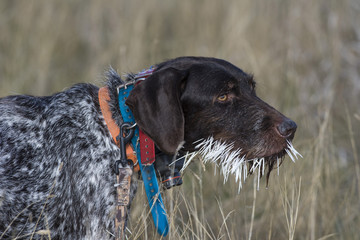Man (or woman’s) best friend has long been considered the dog. Dogs add so much joy to our lives that it is difficult to not think of them as members of our family. Because of that, we’ve decided to put together a list of four things that threaten our dogs in the summertime and what can be done to keep our best friend safe.
Even if this list serves as nothing more than a reminder, make sure you’re just as prepared for the dog as you care for yourself. Regardless of how safe we are though, things still go wrong, and when they do, you’ll want to know what to do so you can react quickly to help your endangered pet.
-
The Sun
The most common threat to a dog in the summer is the sun. It can cause sunburns, burnt paws, heatstroke, and dehydration. Keeping your dog cool is a must especially when temperatures soar into the 90s. Dogs don’t sweat like humans, so it’s much harder for them to cool off than it is for us. If you must leave them outside, make sure they have adequate shade and a lot of cool water, also preferably in the shade.
. 4 Things You SHOULDN’T Do & 2 Things You SHOULD Do With Your Pet In Summer
You should avoid taking a dog for a walk during the hottest part of the day for two reasons: you don’t want them to burn the pads of their paws, nor do you want them to get dehydrated. If you do go for a walk, it is always a good idea to bring enough water for both of you to make sure everyone, two-legged and four-legged, stays hydrated.
Learning the signs of heatstroke will also come in handy, but hopefully, you’ll never go through that! If you know the signs, however, and the worst does happen, you can make sure your pet makes it to the animal hospital or veterinarian sooner to prevent permanent damage or death.
2. Ticks
Ticks are nasty little creatures. They carry disease and burrow deep often under a dog’s fur where they are hard to find until the skin begins to fester and the irritation builds. Unfortunately, ticks can infest even the dogs that aren’t outside often. Once attached to your dog, certain female ticks can cause a rare paralysis in dogs as a result of a toxin they produce while feeding while spreading diseases. The disease with which most people are familiar is called Lyme disease but another is Rocky Mountain spotted fever. Lyme disease can cause arthritis and swelling of your dog’s joints, resulting in painful lameness. Rocky Mountain spotted fever can cause fever, lameness, and other signs. There are also other diseases that ticks can transmit to your dog.
Use flea and tick prevention products to at least boost your dog’s chances of NOT getting ticks. Use tick prevention products regularly and as directed by a veterinarian based on your particular area. Some things could work better than others. There are so many options that no dog should be unprotected. You can choose from topical oils, pills, collars, and sprays.
3. POOLS & LAKES
Not all dogs are the best swimmers. Some are, and if you know your dog can handle water, let him swim! But if you don’t know, don’t assume you can just toss your pup into the lake and he’ll take to it. There is still the potential for drowning.
If you are going on a boat with a dog that doesn’t care for water or can’t swim, put a life jacket on him. You would think he’ll never fall overboard, but stranger things have happened and it’s simply better to be prepared. If your dog is new, or this is your first summer with your best friend, make sure you take it slow and monitor the dog as he experiences the lake or the ocean for the first time.
4. Porcupines
The porcupine is the worst friend of the dog! These creatures can do major damage to your pet! Do some research and see if porcupines are common in your area. If they are, this is definitely a threat to be concerned about during the summer months a quick response is necessary!
 Having a dog come back to you with porcupine quills stuck all over his face is one of the worst feelings a pet owner can possibly experience. (Ask me how I know!) Dogs get very curious and don’t understand until it’s too late just how unfriendly a porcupine is. Unfortunately, there isn’t a lot you can do about this one except be prepared if you live in an area where porcupines are common.
Having a dog come back to you with porcupine quills stuck all over his face is one of the worst feelings a pet owner can possibly experience. (Ask me how I know!) Dogs get very curious and don’t understand until it’s too late just how unfriendly a porcupine is. Unfortunately, there isn’t a lot you can do about this one except be prepared if you live in an area where porcupines are common.
If your dog does have a run in and ends up with quills all over his face, call the veterinarian as soon as you can. Many have emergency numbers where vets can be reached after hours. You want to act quickly because the longer the quills stay in your dog, the higher the chances are of infection. You should also check to see if ay quills are in your dog’s eyes, nose, throat, or mouth. Not only are these areas highly sensitive, but this can also be an emergency situation and permanent damage may already be done. The vet will likely ask you this on the phone too, so assess the damage. More often than not, you will want to get the dog to the vet as soon as you can!
If your dog only has a few quills in his whiskers, you may be able to pull them out yourself, however, make sure you still get him to the vet to make sure you got them all! Grab the quill with needle-nosed pliers as close to the dog’s skin as you can and pull steadily. Keep in mind that removing porcupine quills is incredibly painful, and your dog may only be able to handle the removal of a few before he lashes out and bites you out of fear and pain. You will most likely have to take him to the vet anyway. The vet will put the dog under anesthesia to remove the rest of the quills. Promptly removing the quills is of the utmost importance as they can travel through the body and damage the organs if left alone.
DO NOT CUT THE QUILL! You may have heard that cutting the quill releases some kind of pressure and it becomes easier to remove. Not only is that untrue, but it also makes the quill harder to get out intact because it splinters the shaft endangering the dog further. If the quill is too short and split, you could break it off by not being able to get a good grip. It’s better to leave it alone and the veterinarian deal with it. In the meantime, discourage your dog from pawing at his face and lodging the quills deeper. (Easier said than done…)
While these common summer dangers are scary and can be life-threatening, being aware of them and taking the appropriate action when something goes wrong could save your best friend’s life.

This article was originally published at Ready Nutrition™ on August 13th, 2019








I just lost my big sweet boy to a foxtail- he inhaled one into his lung and it punctured it. After emergency surgery he didn’t survive. These things enter dogs in every opening from eyes to rear ends. They can also just bore right into the body through the skin. I knew they could lose an eye or get infections but I never fathomed death.
Holly,
I’m so sorry to hear about your sweet boy! 🙁 Foxtails are in my area too and every summer I worry about that. I didn’t realize they could be life-threatening either. How sad.
Whats a foxtail?